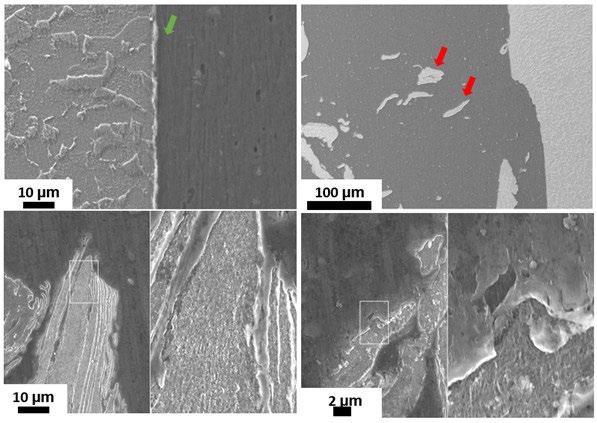
13 minute read
A.Khaskhoussi, G. Di Bella, C. Borsellino, L. Calabrese, E. Proverbio.......................................................... pag
Microstructural and electrochemical characterization of dissimilar joints of aluminum alloy AW5083 and carbon steel S355 obtained by friction welding
A. Khaskhoussi, G. Di Bella, C. Borsellino, L. Calabrese, E. Proverbio
Over the past twenty years, friction-welding technology, in particular the Friction Stir Welding (FSW) has become a potential industrial welding method that has been used efficiently for combining similar and dissimilar materials. The latter solution is very interesting in ship-building, where the use of aluminum in the superstructures allows lowering of the center of gravity for a better stability of the ship. In making dissimilar joints, the FSW technique is more cost and time efficient, allows to weld various sheet thickness with different joint configurations. In this work a coupled mechanical, metallurgical and electrochemical characterizations of dissimilar joints of aluminum alloy AW5083 and carbon steel S355 obtained by butt joint welding (FSW) were performed. The results showed that during the FSW process several well-defined microstructural zones are generated, that affected the mechanical performances and the corrosion behavior of the weld.
KEYWORDS:DISSIMILAR JOINTS; FRICTION STIR WELDING; ALUMINUM ALLOY; CARBON STEEL; LOCAL ELECTROCHEMICAL MEASUREMENTS;
INTRODUCTION Research on joining of steel to aluminum alloys is of great importance due to the rising demand for lightweight construction in several industries especially the marine one [1]. However, the main obstacles to attaining effective dissimilar joining of steel and aluminum are the wide differences in their mechanical, chemical and physical properties. In addition, the high heat input of fusion welding processes induces the formation of brittle and thick intermetallic compounds (IMCs) causing the reduction of the performances of the produced joints [2]. Thus, a lower heat input is essential for fabricating a high-quality joint between steel and aluminum. One of the promising and new solid-state welding techniques for joining of different metals and alloys is friction stir welding (FSW). FSW has several advantages over more standard techniques, such as the short welding time, low heat input, and superior mechanical properties of the weld [3]. Furthermore, due to its working principle, FSW allows for welding with few to no imperfections common in fusion welding, such as lack of fusion, cracking, warAmani Khaskhoussi, Guido Di Bella, Chiara Borsellino, Luigi Calabrese, Edoardo Proverbio
Department of Engineering, University of Messina, Contrada di Dio Sant’Agata, 98166 Messina, Italy
akhaskhoussi@unime.it, lcalabrese@unime.it , eproverbio@unime.it
ping porosity, distortion, loss of alloying elements, and formation of oxide due to the lower heat inputs [4]. Despite the numerous studies devoted to the production of aluminum/steel joints by FSW, much less attention has been paid to their electrochemical behavior. In this study, we evaluate the relationships between the metallographic structure, the mechanical behavior and the electrochemical performances of aluminum alloy AW5083/S355 steel joint obtained by FSW using different techniques: microhardness indentation, Scanning electron microscopy (SEM), energy dispersive X-ray spectroscopy (EDS) and electrochemical tests.
MATERIALS AND METHODS Five mm thick S355 steel sheet was joined by Friction Stir Welding (FSW) with the aluminum alloy EN AW-5083 H111 (5 mm thick) in the butt weld configuration provided by the company RIFTEC (Geesthacht, Germania). Friction stir welding was done with welding speed of 300 mm/min at 400 rpm using force control at 30kN. Then, the samples were cut transversally (cross section), grinded, polished, and etched with nital (2%) for 20 seconds at room temperature. At the end, the specimens were rinsed with cold bidistilled water and ethanol and dried with warm air. Microhardness was measured on cross-sections extracted from the middle of the welds, a region that is representative of the stable length of each weld. The vickers hardness measurements were carried out using FUTURE-TECH FM-300e with a load of 500g. As indicating in the ASTM E384-17 standard (Standard Test Method for Microindentation Hardness of Material), a minimum spacing distance between two indentations of 2.5 times the value of indent diagonal was respected. The weld zones and other microstructural features were also investigated by optical microscopy, following standard metallographic preparation. Morphological analysis was performed by scanning electron microscopy (SEM-FIB Zeiss Cross Beam 540). Furthermore, the composition of the different areas was determined by energy dispersive spectroscopy (EDS) (Aztec Oxford). Minicell techniques (about 0.785 mm2) was adapted for electrochemical characterization. A Tensiometer was used to control the flow of the fresh solution over the selected working electrode area. The Al-Steel interface was analyzed by means of Scanning Kelvin Probe (SKP) test was performed using BioLogic electrochemical workstation. The step scan mode was applied with a step size of 20µm using kelvin probe having a tip size of 0.5 mm.
RESULT AND DISCUSSION
Fig.1 - SEM images showing the Al/steel interface. Green arrow indicates the Al-steel interface; red arrows indicate steel debris in Al matrix; bottom images refer to different magnification images of the steel debris.
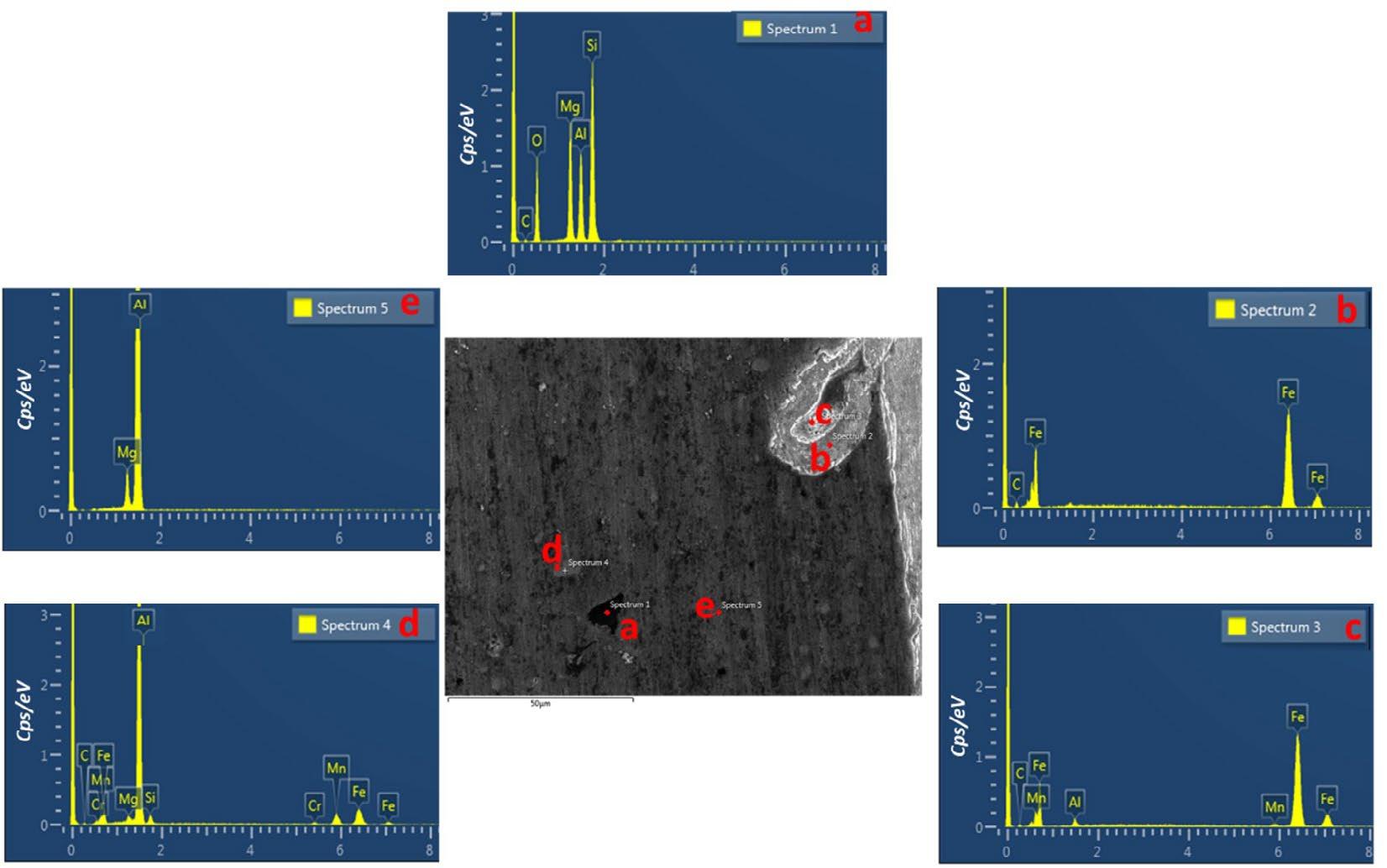
Fig.2 - The EDS elemental analysis results from different points near the weld interface.
Cross section of weld was observed by scanning electron microscope (SEM), at the aluminum and steel interface and the different micrographs are reported in Fig.1. The formation of a thin intermetallic compound (IMC) layer (showed by the green arrow) at aluminum and steel interface caused by the frictional heating on the surface under the action of the rotating shoulder, can be noticed [1]. Some fragments scattering in the Al matrix were also formed (red arrows). The Energy Dispersive Spectroscopy (EDS) analyses were conducted to identify fragments composition and characterize the weld interface. The results were summarized in Fig. 2. The EDS analysis finds the presence of Al, Mg, Si in the selected zone “a”. The EDS analysis in the point “b” confirms that the fragments present in the Al matrix are formed principally by Fe. This phenomenon is probably due to the stirring effect of the pin, which pulled small bits of steel from the surface and scattered them in the aluminum [2]. Indeed, the steel fragments that were sheared off from the surface of the steel edge were scattered in the Al matrix because of the tool movement in the feed path. As well, there is no clear presence of stirred aluminum or particles in steel nugget due to the difficulty of insertion the soft metal (Al) in hard metal (Steel), and the steel did not reach the degree of plasticity to make it easy for intercalation. The EDS analysis was performed also in the weld interface (point “c”) to examine whether intermetallic compounds were formed in the steel and the aluminum alloy interface. The results suggest that an intermetallic compounds were formed and composed of Al, Fe and Mn [2,3]. According to Elnabi at al. the steel fragments can also react with the aluminum matrix and formed brittle IMCs. Indeed, the larger steel fragments react with Al to make a thick IMC layer around the fragment. The core of the particle influences by dynamic recrystallization that makes it more fine grains. Whereas the smaller particles transfer to a complete IMC particle [3]. The EDS of the point “d” shows a phase rich in Al, Mg, Si, Mn, Cr and Fe. Similar spherical precipitates believed to consist primarily of Mg and Al were reported in the study of the Al 5083 microstructure [4]. The point “e” indicated the presence of aluminum-magnesium intermetallic precipitates or inclusions in the aluminum microstructure [5]. To understand the effect of these microstructure features on the mechanical properties of the welding a detailed study of the hardness profile and its relationship with the microstructure was conducted and discussed in the next section. The results of the Vickers indentation, realized using the microhardness across the thickness section of dissimilar weldments versus the distance are plotted in Fig.3 to evaluate the variation of the micro-hardness across the joint.
The profile exhibits a non-symmetrical trend due to the different physical and mechanical properties of dissimilar base materials. The hardness profile confirms also the existence of interfacial area between the aluminum alloy and the steel sides in the stirred zone (indicated as SZ in the figure). Indeed, four zones can be distinguished after the FSW process: Base metal, the stir zone, thermo-mechanical affected zone (TMAZ) and the heat-affected zone (HAZ). According to the present results, the hardness values on the aluminum side were almost constant in all directions because the aluminum base metal is a non-heat-treatable, work-hardened aluminum alloy [6]. Thus, no significant FSW effect on the hardness of the aluminum HAZ and the THAZ zones. The average hardness aluminum zone (base metal) is around 55 HV, while it is 158 HV in the base steel. The highest values of hardness was observed on steel THAZ. The maximum reached value of hardness in this zone is about 212 HV. Then the hardness gradually decreases in the direction of the HAZ, but it is still higher than the base steel. Thus, the narrow HAZ and TMAZ formed in the steel region, due to rapid cooling from the estimated peak temperature down to atmosphere, have higher hardness then the base metal. To understand this difference in the hardness behavior of the different welding zones, the microstructures of the different regions were evaluated.
Fig.3 - Hardness distribution perpendicular to the AW 5083/S355 interface (a) Optical images showing the microstructure of different regions (b).
Optical images showing the microstructure of different regions are illustrate in Fig.3.b.The grain structure of all areas has the possibility of deformation during the FSW process. According to these presented results, the grain structure in HAZ, TMAZ and especially in the SZ region is largely refined which explains the difference in hardness values. The SZ, TMAZ and HAZ have a smaller grain size than the steel base metal due to the recrystallization of these grains when heated by the tool stirring action. In addition, the TMAZ and HAZ are formed due to the recrystallization of steel grains. In fact, the main controlling mechanisms for such grain structural modification are based on the operative dynamic restoration phenomena during the FSW process. The involved mechanisms mostly include dynamic recovery (DRV), continuous dynamic recrystallization (CDRX), discontinuous dynamic recrystallization (DDRX), and geometric dynamic recrystallization (GDRX) depending on the stacking fault energy of the examined metals and alloys. Indeed, grains can nucleate during severe plastic deformation of friction-stirring process, and in following cooling from the peak temperature after the FSW process will render the grain growth, and the rate of grain boundaries migration lead to the formation of a fine grain structure in steel side of dissimilar weld [7].
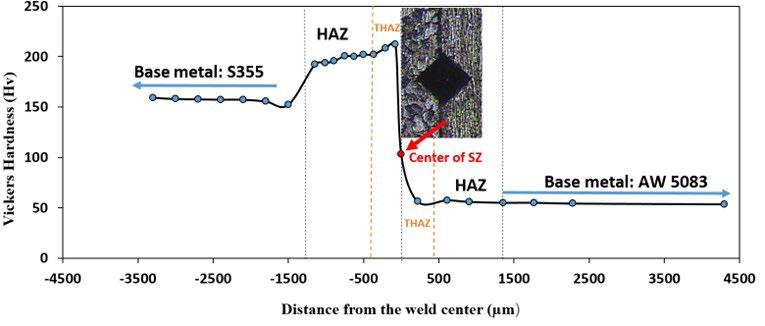

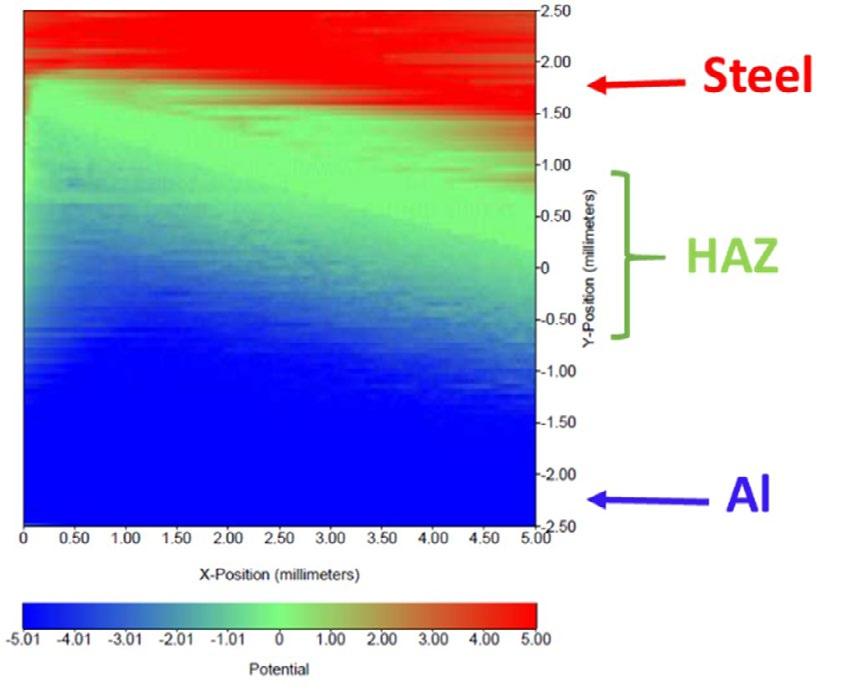
Fig.4 - SKP measurement of AW 5083 Aluminum/ S355 Steel dissimilar joint.
The SKP and Polarization tests are reported in Fig. 4. It is observed that there is a considerable difference in the surface potential between the intermediate zone (HAZ+SZ+THAZ) (green) and the two base metals. This intermediate zone has a surface potential less than the aluminum alloy (blue) and higher than the steel zone (red), confirming that the aluminum region is anodic whereas the steel zone is more cathodic in nature. Although, there is a gradual decrease of potential from aluminum to steel going through the intermediate zone indicating that this zone has an intermediate corrosion behavior.
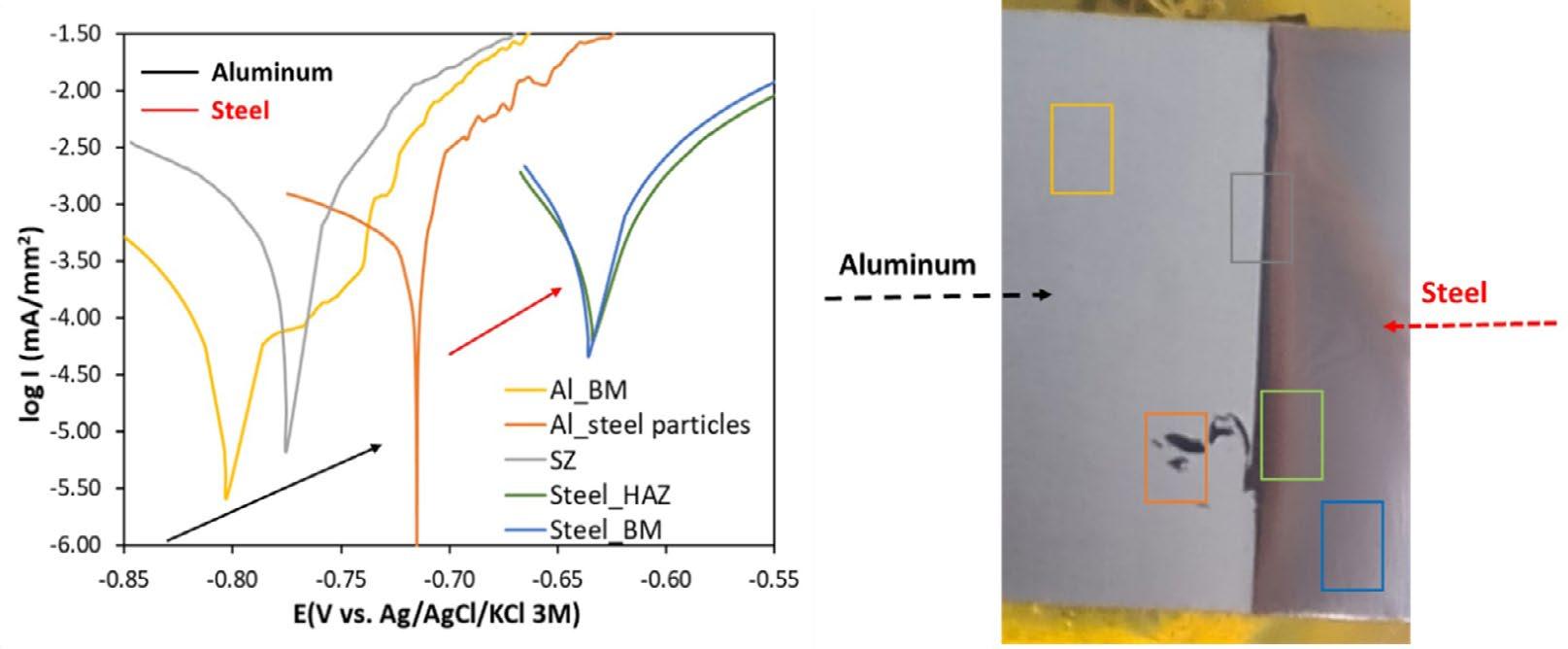
Fig.5 - Microcell polarization tests of AW 5083 Aluminum/S355 Steel dissimilar joint.
The Electrochemical tests performed on the AW 5083 Aluminum and the S355 steel give an insight into various details of their corrosion behavior such as the corrosion kinetics, passivity and the electrochemical behavior of the alloys among other things. The electrochemical behavior of the alloys depends on several factors such as the intermetallic particles and phases and even the production methods of the alloy. All potentiodynamic polarization measurements were started 5 minutes after the surface contact with the minicell (Fig. 5). The aluminum base material exhibits, Ecorr of around -810 mV and a pitting potential of around -731 mV. The corrosion current density (Icorr) measured for the aluminum alloy is below 10-4 mA/mm-2. At the pitting potential, the current density increases immediately up to value six times higher than Ecorr. The free corrosion potential of the steel shows a value of about -630 mV. However, the heat-affected zone of the steel shows a slightly higher corrosion potential and lower corrosion current than the base metal demonstrating that the heat effect slightly decreases the corrosion rate, which is probably related to the hard-
ness increase. The interface zone showed an intermediate corrosion potential of about -710 mV indicating that the thin intermetallic layer formed during the FSW process did not affect negatively the corrosion resistance of the joint unlike in the case of fusion welding [8].
CONCLUSIONS In the present study, a dissimilar joints of aluminum alloy AW5083 and carbon steel S355 obtained by friction welding were characterized and the relationship between their microstructural features and their electrochemical behavior were discussed. The results showed that: • The SZ, TMAZ and HAZ have a smaller grain size than the steel base metal due to the recrystallization of these grains by the tool stirring action. • The maximum value of hardness of about 212 HV was reached in the HAZ, whereas the value was 55 HV in the aluminium and 158 HV in the steel. • The zones formed during the FSW such as the stir and the heat affected zones did not affect negatively the corrosion resistance of the joint.
ACKNOWLEDGMENT The authors acknowledge the SIMARE funding under the reference “Code 08ME7219090182 - CUP G48I18001090007, University of Messina”
REFERENCES
[1] T. Tanaka, M. Nezu, S. Uchida, T. Hirata, Mechanism of intermetallic compound formation during the dissimilar friction stir welding of aluminum and steel, J. Mater. Sci. 55 (2020) 3064–3072. https://doi.org/10.1007/s10853-019-04106-2. [2] K. Martinsen, S.J. Hu, B.E. Carlson, Joining of dissimilar materials, CIRP Ann. 64 (2015) 679–699. https://doi.org/10.1016/J. CIRP.2015.05.006. [3] R. Hatano, T. Ogura, T. Matsuda, T. Sano, A. Hirose, Relationship between intermetallic compound layer thickness with deviation and interfacial strength for dissimilar joints of aluminum alloy and stainless steel, Mater. Sci. Eng. A. 735 (2018) 361–366. https://doi. org/10.1016/J.MSEA.2018.08.065. [4] N.R. Ramesh, V.S.S. Kumar, Experimental erosion-corrosion analysis of friction stir welding of AA 5083 and AA 6061 for sub-sea applications., Appl. Ocean Res. 98 (2020) 102121. https://doi.org/10.1016/J.APOR.2020.102121. [5] G. Lucadamo, N.Y.C. Yang, C.S. Marchi, E.J. Lavernia, Microstructure characterization in cryomilled Al 5083, Mater. Sci. Eng. A. 430 (2006) 230–241. https://doi.org/10.1016/J.MSEA.2006.05.039. [6] A. Elrefaey, M. Gouda, M. Takahashi, K. Ikeuchi, Characterization of aluminum/steel lap joint by friction stir welding, J. Mater. Eng. Perform. 14 (2005) 10–17. https://doi.org/10.1361/10599490522310. [7] T.R. McNelley, S. Swaminathan, J.Q. Su, Recrystallization mechanisms during friction stir welding/processing of aluminum alloys, Scr. Mater. 58 (2008) 349–354. https://doi.org/10.1016/J.SCRIPTAMAT.2007.09.064. [8] A. Canakcı, S. Ozkaya, F. Erdemir, A.H. Karabacak, M. Celebi, Effects of Fe–Al intermetallic compounds on the wear and corrosion performances of AA2024/316L SS metal/metal composites., J. Alloys Compd. 845 (2020) 156236. https://doi.org/10.1016/J. JALLCOM.2020.156236.
Negli ultimi venti anni, la tecnologia della saldatura ad attrito, Friction Stir Welding (FSW), è diventata un potenziale metodo di giunzione industriale che è stato utilizzato in modo efficiente per la giunzione di materiali simili e dissimili. Quest’ultima soluzione risulta essere molto interessante in campo navale, dove l'utilizzo dell'alluminio nelle sovrastrutture permette l'abbassamento del baricentro per una migliore stabilità della nave. Nella realizzazione di giunti dissimili, la tecnica della FSW è più efficiente in termini di costi e tempi, permettre di saldare efficacemente vari spessori di lamiera con diverse configurazioni di giunti. In questo lavoro è stata eseguita una caratterizzazione meccanica, metallurgica ed elettrochimica accoppiata di giunti dissimili di lega di alluminio AW5083 e acciaio al carbonio S355 ottenuti mediante saldatura ad attrito (FSW) di testa. I risultati hanno evidenziato che durante il processo FSW si generano diverse zone microstrutturali ben definite, che influiscono sulle prestazioni meccaniche e il comportamento alla corrosione della saldatura.
PAROLA CHIAVE: GIUNTI DISSIMILI, FRICTION STIR WELDING, LEGA DI ALLUMINIO, ACCIAIO AL CARBONIO, ANALISI ELETTROCHIMICA LOCALE.
TORNA ALL'INDICE >








